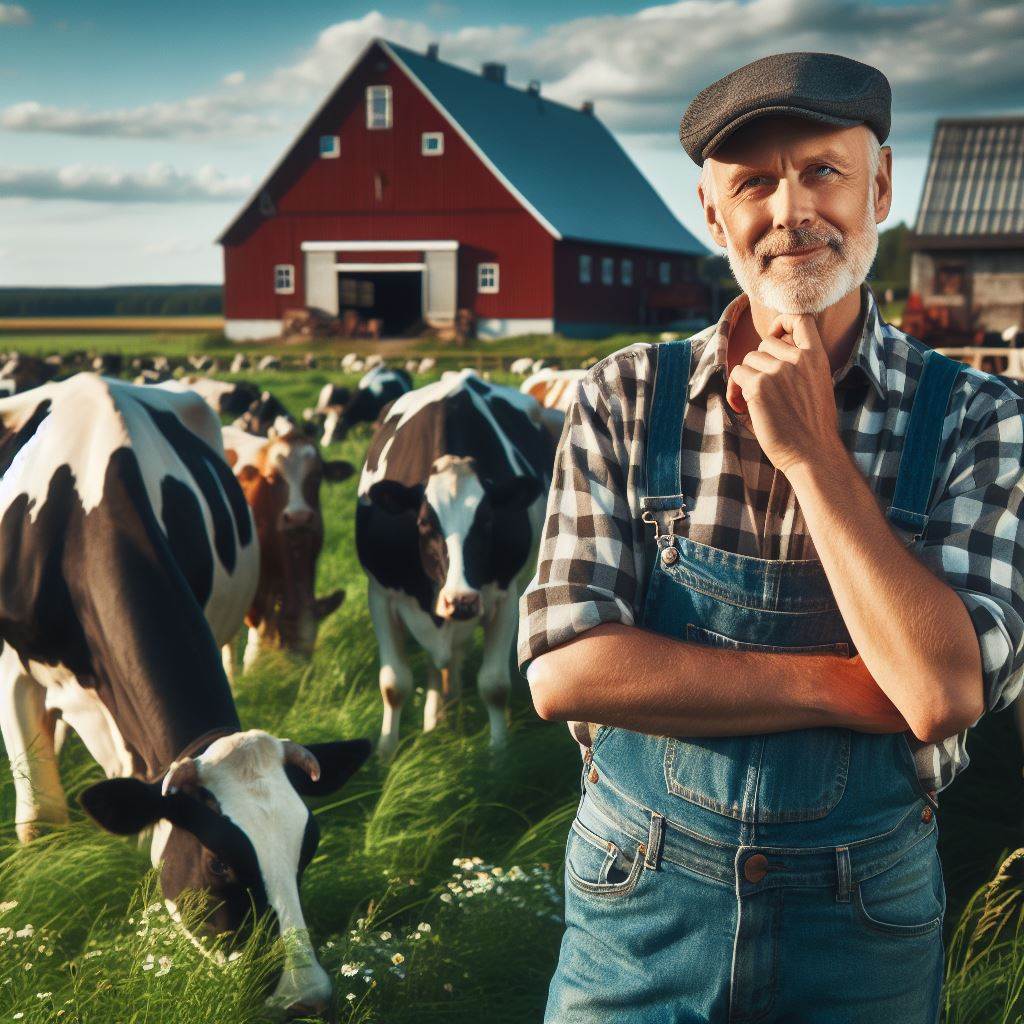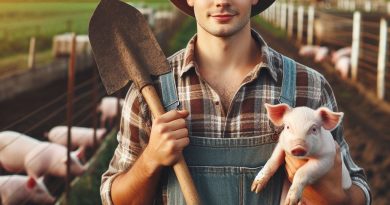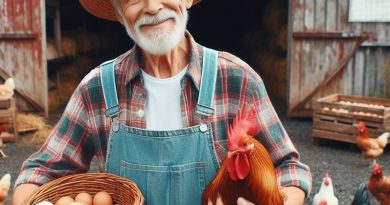Beef Cattle Grazing: Best Practices
Last Updated on March 2, 2024
Introduction
Beef cattle grazing is a crucial aspect of livestock farming, allowing cattle to feed on natural pastures.
Implementing best practices in grazing is vital for the success and sustainability of cattle farming operations.
By following these practices, farmers can improve cattle health, optimize land use, and support environmental conservation.
It is essential to ensure adequate nutrition, manage herd size and grazing duration, and adopt rotational grazing methods.
Implementing best practices also helps manage pasture vegetation, prevent overgrazing, and reduce soil erosion.
Properly managed grazing systems improve soil fertility, water quality, and carbon sequestration, benefiting the ecosystem.
Incorporating grazing practices that prioritize animal welfare enhances cattle performance, behavior, and overall productivity.
Adhering to guidelines and regularly monitoring cattle ensures optimal health and minimizes the risk of disease transmission.
Efficient grazing practices reduce costs associated with feeding and improve the economic viability of cattle farming.
Additionally, sustainable grazing practices contribute to the overall sustainability of the agricultural industry by conserving resources.
By prioritizing best practices in beef cattle grazing, farmers can achieve long-term success and environmental stewardship.
Overall, adopting and implementing these practices is crucial for the future of beef cattle farming.
Benefits of Beef Cattle Grazing
Beef cattle grazing is a widely practiced method of feeding that brings multiple benefits to both farmers and the environment.
This section will explore the advantages of beef cattle grazing, which include increased feed utilization, improved soil health and fertility, cost-effectiveness, and enhanced biodiversity and ecosystem services.
Increased efficiency in feed utilization
Grazing allows cattle to consume forage directly from pastures, leading to increased efficiency in feed utilization.
By grazing on natural grasses, cattle can extract maximum nutrients from the plants, resulting in healthier animals and reduced feed costs for farmers.
Improving soil health and fertility
Beef cattle grazing plays a pivotal role in improving soil health and fertility.
As cattle graze, their hooves break up the soil, increasing its porosity and reducing compaction.
This enhances water infiltration and nutrient cycling, promoting the growth of beneficial microorganisms and ultimately improving soil fertility.
Cost-effectiveness compared to other feeding methods: Grazing is a cost-effective feeding method compared to other alternatives.
With grazing, farmers minimize the need for purchasing expensive grains or creating elaborate feeding systems.
By utilizing natural pastures, farmers can significantly reduce their production costs, contributing to higher profitability.
Enhancing biodiversity and ecosystem services
- Grazing not only benefits farmers but also the surrounding environment by promoting biodiversity and providing essential ecosystem services.
- Cattle grazing can help maintain open landscapes, preventing encroachment of invasive plant species and preserving native grasslands.
- This, in turn, supports a diverse range of wildlife habitats.
- Additionally, grazing can aid in controlling undesirable plant species, reducing the need for herbicides and promoting a more sustainable approach to weed control.
- The presence of cattle also contributes to nutrient cycling, as their manure adds valuable organic matter to the soil, further enhancing ecosystem services.
In short, beef cattle grazing brings numerous benefits to both farmers and the environment.
It increases feed utilization efficiency, improves soil health and fertility, offers cost-effectiveness compared to other feeding methods, and enhances biodiversity and ecosystem services.
Adopting and promoting responsible grazing practices can help ensure sustainable and profitable beef production while preserving the health and integrity of our ecosystems.
Read: Dairy Farming: Maximizing Milk Yield
Planning and Designing
Selection of appropriate grazing system
- Evaluate the landscape and climate to determine the most suitable grazing system for your beef cattle.
- Consider factors such as terrain, soil type, water availability, and forage quality when choosing a grazing system.
- Popular grazing systems include continuous, rotational, cell, and strip grazing, each with its advantages and disadvantages.
- Consult with local agricultural extension services or experienced ranchers to seek advice on the best grazing system for your specific circumstances.
Rotational grazing benefits and tips
- Rotate cattle through different grazing areas to promote optimal pasture health and provide efficient forage utilization.
- Rotational grazing helps control weeds and parasites, enhances forage regrowth, and reduces soil erosion.
- Divide pastures into smaller paddocks and limit grazing time to allow for adequate rest and recovery of grass.
- Monitor forage growth and adjust rotation schedules accordingly to prevent overgrazing and ensure consistent forage supply.
Determining stocking rates and carrying capacity
- Properly assess your pasture’s carrying capacity to determine the maximum number of cattle it can support throughout the year.
- Consider factors like forage availability, grazing intensity, and seasonal variations when calculating stocking rates.
- Consult with range management specialists and utilize tools like the NRCS Grazing Lands Economics Excel spreadsheet for accurate calculations.
- Regularly monitor and adjust stocking rates to maintain forage health, avoid overgrazing, and prevent underutilization of available resources.
Fencing and water source considerations
- Install sturdy and secure fencing to keep beef cattle contained and protect pasture areas from unauthorized entry.
- Utilize a combination of permanent and portable fencing to facilitate rotational grazing and pasture management.
- Consider using electric fencing for easier mobility and flexibility in managing grazing areas.
- Ensure reliable and easily accessible water sources for your cattle within each grazing paddock.
- Consider water requirements based on cattle numbers, climate conditions, and potential alternative water sources like ponds or streams.
In general, the beef cattle grazing planning involves selecting a suitable system, implementing rotational grazing, optimizing stocking rates, and addressing fencing and water needs.
By employing these best practices, cattle farmers can effectively manage their grazing areas, improve forage utilization, and ensure the overall health and productivity of their beef cattle operation.
Remember to regularly assess and adjust your management strategies to adapt to changing conditions and maximize the potential of your grazing system.
Read: Duck Nutrition Guide: Feeding for Healthy Flocks
Pasture Management
Proper Forage Selection and Planting
- Selecting the right forage is crucial for successful pasture management.
- Consider the nutritional requirements of your beef cattle when choosing forage species.
- Choose forages that are well-adapted to your region’s climate and soil conditions.
- Consider the availability and cost of forage seeds when deciding what to plant.
- Opt for a diverse mix of forages to ensure a balanced diet and reduce the risk of overgrazing.
- Implement rotational grazing to allow forage regrowth and prevent overgrazing.
Importance of Soil Testing and Fertilization
- Conduct regular soil tests to assess nutrient levels and pH in your pastures.
- Based on soil test results, apply fertilizers to correct nutrient deficiencies and improve soil fertility.
- Properly fertilized pastures support healthy plant growth and provide nutrition for grazing beef cattle.
- Avoid over-application of fertilizers, as it can lead to nutrient runoff and water pollution.
- Consult with a local agricultural extension agent for specific fertilizer recommendations based on your soil type and forage species.
Weed and Brush Control Methods
- Implement an integrated weed management plan to control unwanted plants in your pastures.
- Regularly scout your pastures and identify weed species that could compete with desirable forages.
- Use cultural practices such as proper grazing management and maintaining healthy soil to prevent weed growth.
- Mechanical methods such as mowing or hand-pulling can be effective for controlling small weed infestations.
- Herbicides can be used selectively to target specific weed species while minimizing damage to desirable forages.
- Utilize proper timing and application techniques when using herbicides to maximize effectiveness and minimize environmental impact.
Managing Forage Quality and Quantity
- Monitor forage quality by assessing its nutritional value and palatability for beef cattle.
- Regularly sample forages and analyze them to determine their protein, energy, and mineral content.
- Adjust grazing strategies based on forage quality and cattle’s nutritional needs.
- Implement proper grazing rotations to ensure sufficient forage quantity and prevent overgrazing.
- Allow adequate rest periods for pastures to promote forage regrowth and maintain good overall pasture health.
In essence, proper pasture management is crucial for successful beef cattle grazing.
Choosing suitable forages, conducting soil tests, fertilizing, controlling weeds, and managing forage quality sustainably ensures cattle health and productivity.
Remember, a well-managed pasture provides the foundation for a profitable and sustainable beef cattle operation.
Read: Alpaca Feed Tips: Nutrition for Fleece Quality
Animal Health and Nutrition
In order to ensure the overall well-being of beef cattle, it is essential to provide them with a balanced diet. This includes a combination of forage, grains, and supplements.
Providing a balanced diet for cattle
Cattle should have access to high-quality forage, such as grass or hay, which serves as their primary source of nutrition.
In addition to forage, grains can be included in the diet to provide energy and help meet the nutritional requirements of the animals.
It is important to work with a veterinarian or animal nutritionist to develop a diet that is appropriate for the specific needs and stage of production of the cattle.
The diet should be adjusted based on the weight, age, and reproductive status of the animals, as well as the availability of forage and grains.
Considerations for Mineral Supplementation
Cattle need access to a variety of minerals to maintain proper health and productivity.
It is important to conduct regular mineral testing of soil, forage, and water to determine any deficiencies or imbalances.
Based on these test results, specific mineral supplements can be added to the diet to ensure that the cattle receive the necessary nutrients.
Common minerals that may need to be supplemented include calcium, phosphorus, magnesium, and sodium.
Water needs and access
Cattle require an adequate and easily accessible supply of fresh and clean water at all times.
Water intake is directly related to feed intake and overall animal health.
Cattle can consume large quantities of water, especially during hot weather or when lactating, so it is important to monitor and provide sufficient water supply.
Water sources should be regularly checked and maintained to ensure they are free from contamination and easily accessible for the cattle.
Monitoring and addressing common health issues
- Regular monitoring of cattle health is crucial to prevent and address any potential issues promptly.
- Common health issues in beef cattle include respiratory diseases, parasites, and foot problems.
- Proper vaccination protocols can help prevent diseases, while monitoring for symptoms and consulting a veterinarian can aid in early identification and treatment.
- Regular hoof trimming, parasite control, and appropriate housing conditions can help minimize health problems.
By following these best practices for animal health and nutrition in beef cattle grazing, farmers can ensure optimal productivity and overall well-being for their cattle.
Providing a balanced diet, considering mineral supplementation, addressing water needs, and monitoring common health issues are all essential in promoting a healthy and thriving herd.
Remember to work closely with professionals in the field to tailor the management practices to the specific needs of the cattle and the environment in which they are raised.
Read: Nutritional Needs of Turkeys: A Complete Guide

Grazing Techniques and Monitoring
Rotational grazing management
- Divide pasture into smaller paddocks to control grazing patterns and allow for proper recovery periods.
- Rotate cattle to different paddocks regularly to ensure even forage intake and prevent overgrazing.
- Utilize electric fencing or temporary fencing to easily move cattle from one paddock to another.
- Monitor and adjust rotation scheduling based on forage growth and cattle needs.
Pasture rest and recovery periods
- Allow pastures to rest after grazing to promote plant regrowth and prevent overgrazing.
- Calculate rest periods based on the growth rate of forage species to ensure adequate recovery.
- Rest periods can vary depending on factors like season, weather conditions, forage type, and stocking density.
- Plan grazing rotations to ensure enough rest periods for each pasture throughout the grazing season.
Monitoring grazing intensity and forage utilization
- Regularly assess the amount of forage consumed in each paddock to gauge grazing intensity.
- Use techniques like visual estimation, clipping samples, or weighing portable exclosures to measure forage utilization.
- Monitor forage height and density to determine if cattle are efficiently utilizing available forage.
- Evaluate grazing charts and record observations to identify potential issues or opportunities for improvement.
Adjusting grazing practices based on observations
- Utilize management tools like grazing charts, pasture maps, and record-keeping to track grazing patterns over time.
- Observe cattle behavior, body condition, and health to assess how well the current grazing practices are working.
- Adjust stocking rates, rotation intervals, or rest periods based on observed forage utilization and plant recovery.
- Continuously monitor and adapt grazing practices to optimize grazing efficiency and maintain pasture health.
By implementing these grazing techniques and monitoring practices, beef cattle producers can enhance pasture productivity, optimize forage utilization, and maintain a healthy grazing ecosystem.
You Might Also Like: Summer Health Tips for Small Ruminants
Environmental Stewardship
Environmental stewardship plays a crucial role in the beef cattle grazing industry.
To ensure sustainability and minimize environmental impacts, farmers must adhere to best practices.
In this section, we will explore three key aspects of environmental stewardship: soil erosion reduction, riparian area protection, and proper manure management.
Conservation Practices to Reduce Soil Erosion
Implementing effective conservation practices is vital to prevent soil erosion on grazing lands.
Farmers should utilize rotational grazing systems, which involve dividing pastures into smaller plots and rotating cattle between them.
This method allows for better management of forage growth and prevents overgrazing, reducing soil erosion. farmers can maintain vegetative cover on their lands by using cover crops and practicing no-till farming.
These strategies promote the infiltration of water into the soil, preventing runoff and erosion.
Contour plowing and terracing are also effective methods for reducing soil erosion on sloping lands.
Riparian Area Protection
Riparian areas are important ecosystems along streams, rivers, and water bodies that support diverse plant and animal life.
To protect these valuable habitats, farmers must establish buffer zones along water bodies to prevent sediment and nutrient runoff.
These buffer zones act as filters, trapping pollutants and reducing their impact on water quality.
By fencing off riparian areas, farmers can also prevent cattle from directly accessing water bodies, reducing bank erosion and maintaining water quality.
Additionally, controlled grazing in riparian zones can promote healthy vegetation growth and stabilize stream banks, further protecting these critical habitats.
Proper Manure Management
Effective manure management is essential for both environmental and animal welfare reasons.
Farmers must implement proper storage facilities, such as lagoons or composting systems, to prevent nutrient leaching into groundwater.
Regular monitoring of manure application rates ensures that nutrients are not over-applied, reducing the risk of runoff and water contamination.
Farmers can incorporate manure into nutrient management plans, balancing soil and crop needs with the application of manure.
This practice maximizes nutrient utilization and minimizes environmental impacts.
By following these practices, farmers can minimize odors, protect water quality, and promote soil health.
Mitigating Environmental Impacts and Promoting Sustainability
Aside from the practices mentioned above, several other measures can be taken to mitigate environmental impacts and promote sustainability in beef cattle grazing:
- Implementing rotational grazing and proper pasture management to optimize forage utilization and minimize overgrazing.
- Using prescribed grazing practices to maintain a balanced ecosystem, including plant diversity and wildlife habitat.
- Properly managing and conserving water resources, such as through efficient irrigation systems and water recycling.
- Minimizing the use of chemical inputs, including pesticides and fertilizers, to prevent water and soil contamination.
- Adopting energy-efficient technologies and equipment to reduce greenhouse gas emissions and lower the carbon footprint.
in a nutshell, Environmental stewardship is integral to the beef cattle grazing industry.
By implementing conservation practices, protecting riparian areas, managing manure properly, and adopting sustainable strategies, farmers can minimize environmental impacts while ensuring the long-term sustainability of their operations.
Through collective efforts, the beef cattle industry can lead the way in responsible and environmentally conscious agricultural practices.
Economic Considerations
Economic benefits of efficient grazing practices
- Efficient grazing practices can lead to increased forage utilization and reduced feed costs.
- Proper grazing management can improve cattle performance and reduce the need for expensive supplements.
- Effective grazing strategies can optimize pasture productivity and result in cost savings for ranchers.
- Reduced labor and machinery expenses can be achieved through well-managed grazing systems.
Cost analysis of different grazing systems
- Comparative studies can help assess the expenses associated with various grazing systems.
- Factors such as fencing, water supply, and infrastructure costs should be considered when evaluating grazing systems.
- Rotational grazing systems may require initial investments, but they can provide long-term economic benefits.
- Continuous grazing systems may seem cheaper initially, but they can lead to overgrazing and decreased productivity over time.
Importance of record-keeping and monitoring expenses
- Accurate record-keeping enables ranchers to track production costs and make informed management decisions.
- Regular monitoring of expenses allows for identifying potential areas of improvement and cost-saving opportunities.
- Keeping track of expenses helps in budgeting and financial planning for the beef cattle operation.
- Detailed records can assist in evaluating the profitability of specific practices and identifying strategies for improvement.
Potential income streams from pasture-based beef production
- Selling pasture-raised beef can command premium prices in the market, attracting consumers who value quality and sustainability.
- Opportunities exist for diversification by marketing beef products directly to consumers through farmers markets or online platforms.
- Utilizing rotational grazing systems can enhance pasture quality, resulting in improved weight gain and higher-quality beef.
- Implementing value-added practices, such as finishing cattle on high-quality forages, can increase the overall profitability of the operation.
Lastly, incorporating efficient grazing practices can have numerous economic benefits for beef cattle operations.
By considering factors such as cost analysis, record-keeping, and potential income streams, ranchers can optimize their profitability and sustainability in pasture-based beef production.
Conclusion
This blog post has emphasized the importance of implementing best practices in beef cattle grazing.
We have discussed key points such as rotational grazing, proper forage management, and careful planning.
It is crucial for farmers and ranchers to understand the benefits of these practices, including improved soil health, increased forage production, and better animal performance.
By following these guidelines, they can achieve sustainable and profitable grazing operations.
Furthermore, continuous learning and improvement are essential in managing grazing operations.
Staying updated with the latest research, attending workshops or conferences, and seeking advice from experts can help optimize grazing techniques.
By implementing best practices and striving for continuous improvement, farmers can contribute to a healthier environment while also enhancing their profitability and the welfare of their animals.
It is our collective responsibility to ensure the sustainability of beef cattle grazing for future generations.


